人工處理植入催化劑
Artificial inoculation technique already been developed and is found to be most effective and reliable method for enhancement of agar production. Works on commercialization are in progress and expected to make available for general use in the field.
The Agarwood created by artificial inducement is called Cultivated Agarwood or Induced Agarwood. Artificial inducement technique (or Agarwood inducement) consists of two actions: to wound the tree and to pour stimulative agent into this injury, this stimulative agent hereinafter referred to as inoculant. Quantity and quality of cultivated agarwood surrounding the injury depends on the composition of inoculant and the method of transfusing inoculant into the tree.
Nowadays, there are about several tens of inoculants whose composition is kept secret. But in general the main components of inoculant are:
- Some fungi and microfungi, for example: Fusarium oxysporum Schlecht., Cladosporium spp, Cercosporella spp, Aspergillus Phoenicis (Corda) Thom & Currie, Cytosphaera Manganiferae Died, Melanotus flavolivens (Ber
 k. & M.A. Curtis) Singer, Penicillium Citrinum Thom, Chaetonium globosum Kunze, Phaeoacremonium parasitica,…in which Fusarium, Cladosporium and Cercosporella are three of 17 fungi that were found in 9 natural agarwood samples collected from the forest in Thailand, Fusarium and Chaetonium are two fungi found in natural agarwood pieces collected from India.
k. & M.A. Curtis) Singer, Penicillium Citrinum Thom, Chaetonium globosum Kunze, Phaeoacremonium parasitica,…in which Fusarium, Cladosporium and Cercosporella are three of 17 fungi that were found in 9 natural agarwood samples collected from the forest in Thailand, Fusarium and Chaetonium are two fungi found in natural agarwood pieces collected from India. - Some phytochemicals, phytohormones namely: salicylic acid, ethephon, methyl jasmonate, chitosan, sodium bisulfite,..
- Some bacteria, yeast extracts, plant nutrient media and plant regulators
Two main methods  of transfusing inoculant into Aquilaria tree:
of transfusing inoculant into Aquilaria tree:
Dispersing wounding by mechanical injury: to drill several tens (20-100) of hole into which the inoculant is poured. In this case induced agarwood is formed around these spot injury sites. The resulting agarwood from the localized formation is usually in the form of thicker wood chips.
Internal wounding: to transfuse inoculant directly into t he xylem vessels of tree by using transfusion set, in this case only few holes are needed. If the internal wounding technique to be applied then induced agarwood is formed in whole tree along the xylem, from root/base up to the top of the trunk in a systemic manner, but relatively thinner formation of resinous wood.
he xylem vessels of tree by using transfusion set, in this case only few holes are needed. If the internal wounding technique to be applied then induced agarwood is formed in whole tree along the xylem, from root/base up to the top of the trunk in a systemic manner, but relatively thinner formation of resinous wood.
Lately, inoculant operators have adopted to Dispersing wounding, leaving the Internal wounding for few reasons after gaining numerous field experiences … wood rotting is the main drawback.
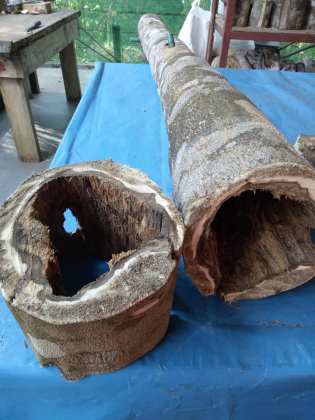
wood rotting by internal wounding
While internal wounding is preferred by certain people, it can be further improved with “Pressurized method”. The air pressure can be portably pumped range 0.5 ~ 1.5 bar, hence minimize local concentration which resulting in tissue rotten. For cost effective, unit can be connected to multiple points, and reusable in next application. This invention is simple, inoculation process completed at faster time, no ingress of rain water even the injection holes are not sealed. Click “Mini pump“.

Dispersing wounding, mechanically wounded with nails, traditional way in Bangladesh

Dispersing wounding, tree drilling and chemical injection.

This effort involves drilling of trees and keeping the wound open by placing a small piece of plastic pipe in those holes followed by a chemical injection to stimulate tree defense mechanism that produces resin. The first project of this effort was initiated in Vietnam under a supervision from Prof. Robert Blanchette, a wood pathologist from the University of Minnesota who together with local farmers and Buddhist monks. They developed experimental plots to stimulate the production of agarwood and after years of trials, this treatment yielded agarwood. Dr. Blanchette stated that this artificial induction could yield agarwood ten times faster than natural formation (WWW page: http://forestpathology.coafes.umn.edu). This finding has gained appreciation and has been considered as one of the most successful finding (Persoon, 2007). This treatment causes tree to respond in two defense mechanisms, physical and chemical. The first is phloem cells form callus and the second, should callus formation is prevented, the tree produces resin.
Dispersing wounding with 10~20ml liquid inoculant, some inoculant service providers utilize upto 100ml per treated hole.




Dispersing wounding, inoculant-soaked bamboo stick, Thailand


Dispersing wounding, inoculation of fungal inoculum
The formation of agarwood is a result of plant defense mechanism towards fungal attacks by producing resinous compounds as secondary metabolite. In their natural habitat, the process of resin accumulation as the result of tree-pathogen battle may take many years and the longer the process takes place the more expensive and highly valuable the resin is. Many scientists have been passionately trying to understand the cascade process of this tree-fungi interaction in producing gaharu. Isolation of various fungi from infected trees have been widely reported.
Surface Inducement Technique ( Agar-SIT )… inoculant is designed to brush on the tree trunk. This technique allows easy agarwood collection, a considerably high yield and good resinous of agarwood could be harvested, along with the sustainable agarwood formation from the same tree. Specifically, this technique is aimed for oil production. Click “Agar-SIT-105” for detail …


Dispersing wounding, non-destrustive harvest, by Pheeraphan Thailand
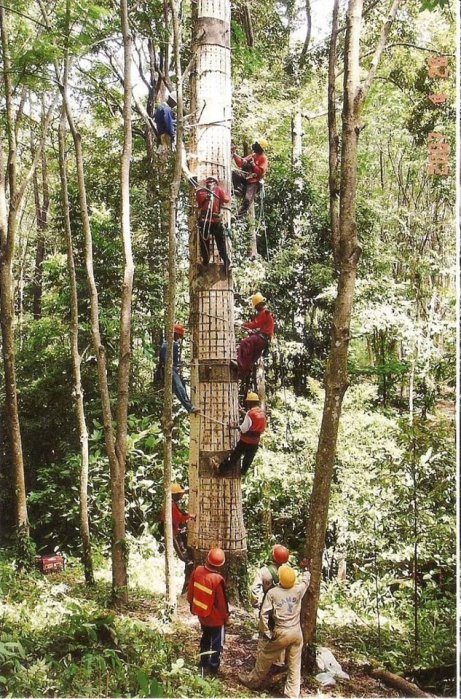

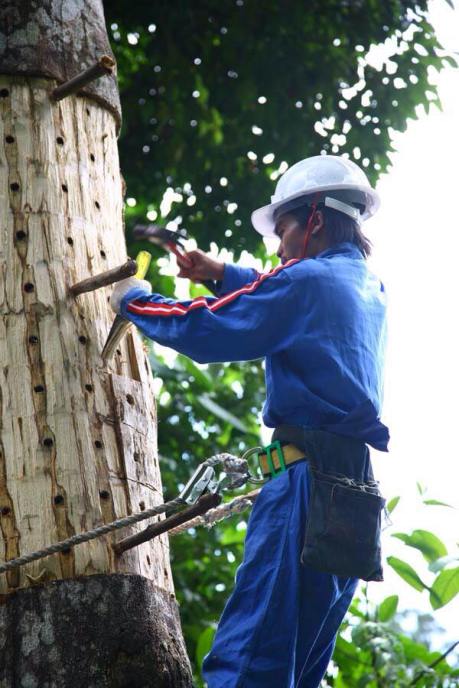

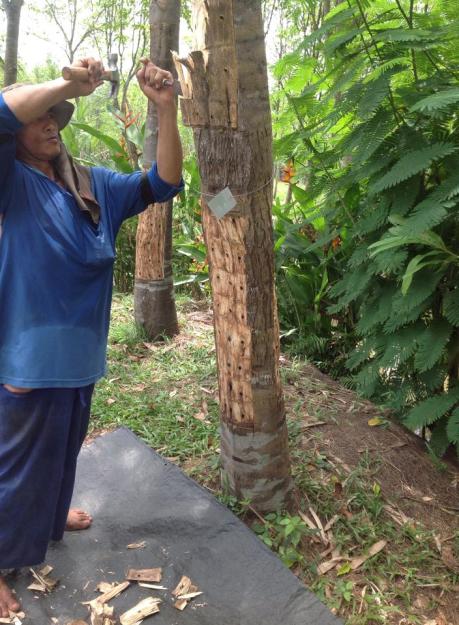


The infected tissue is stripped by chisel
Internal wounding, Single unit, 300ml inoculant per tree, by PENGHARUM.

Internal wounding, Multiple units, by Gaharu Biotech,Pahang.

Gravitically flow.

Application of Chemjet, pressure exerted 0.75bar. Test plot to verify strength of inoculant
Inoculant on Sinensis “Click Here”
Artificial fire method, China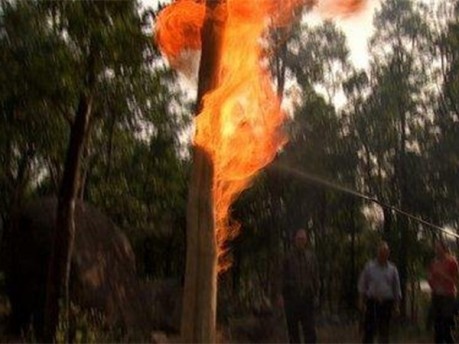 It is to burn the live agarwood tree with a large fire, forcing the agarwood tree to be injured. It looks very cruel, but it does not let the agarwood tree die, so the agarwood tree will mobilize the resin secreted by the immune system to heal the fire, and eventually form agarwood. Select the older tree, peel off the bark from the tree, leave the top leaves, and then use gas torch to burn the whole tree and burn it black. This method is derived from the natural fire or the process of lightning strikes. The agarwood produced in this way is mostly thin, it is used a lot to produce incense.
It is to burn the live agarwood tree with a large fire, forcing the agarwood tree to be injured. It looks very cruel, but it does not let the agarwood tree die, so the agarwood tree will mobilize the resin secreted by the immune system to heal the fire, and eventually form agarwood. Select the older tree, peel off the bark from the tree, leave the top leaves, and then use gas torch to burn the whole tree and burn it black. This method is derived from the natural fire or the process of lightning strikes. The agarwood produced in this way is mostly thin, it is used a lot to produce incense.
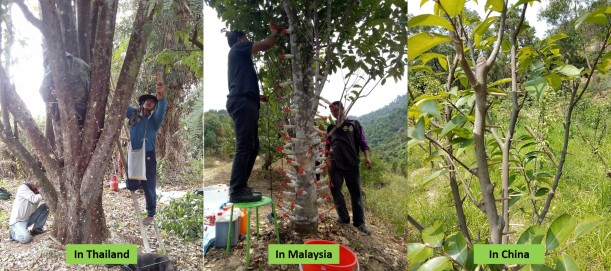 In China, newer species of Kynam has been successfully grafted, this species requires mechanical stress without any injection of liquid inoculant to produce resinous agarwood. Application of soldering device is sufficient for the job. However, the seedlings demand extremely premium price for the moment, click “Kynam”
In China, newer species of Kynam has been successfully grafted, this species requires mechanical stress without any injection of liquid inoculant to produce resinous agarwood. Application of soldering device is sufficient for the job. However, the seedlings demand extremely premium price for the moment, click “Kynam”


Planting money (Agarwood) trees doesn’t come without its challenges. One of these challenges is the inoculation. The Aquilaria tree has to be induced with a infection to induce production of agarwood (the resin), otherwise the tree would be quite worthless. Not all Aquilaria trees produce agarwood, they have to be infected by a certain kind of stress before they start “fighting back” with resin production to counter the infection. And even so, there is no set volume in the resin production (meaning each tree will produce its own amount).













































